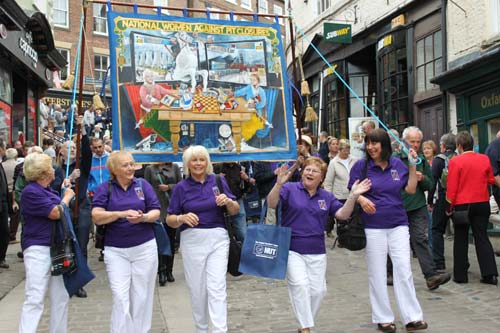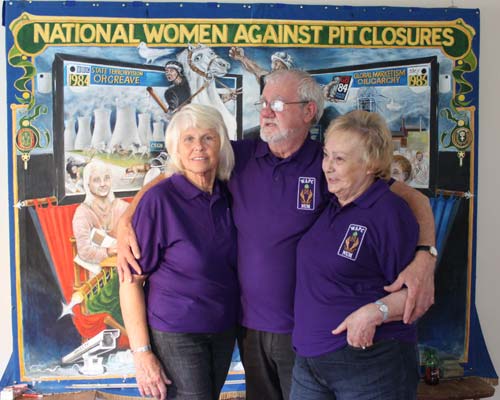Local councillors join Miners' Gala and see new banner designed by Calder Valley artist
Monday, 16 July 2012
A CALDER VALLEY ARTIST has created a key piece in the history of Britain's labour and trades union movement through his painting of a new banner for the Women Against Pit Closures movement.
Women Against Pit Closures Banner, painted by Calder Valley artist,
Andrew Turner - click to enlarge - Photo: Joan Heath
The banner by Andrew Turner, who lives in Todmorden, was raised for the first time last weekend when it was given a place of honour at the Durham Miners' Gala, one of the biggest events staged by the labour and trades union movement in Europe, attended by 100,000 people. The banner was chosen to head a "banner blessing" ceremony by the Bishop of Durham in the city's 900-years-old cathedral. The ceremony is a traditional part of the gala. More than 1,000 people were in the cathedral for the ceremony.
Mr Turner is a professional artist whose lifetime's work has included the painting of two dozen trades union and campaign banners, in addition to hundreds of drawings and paintings.
Mr Turner is the son of a miner and was born in 1939 in a pit community in West Lothian in the Scottish coalfield. After a spell working as a trawlerman he attended art college in Edinburgh, Leeds, and the Royal Academy of Art in London.
His work has had a significant impact nationally and internationally, attracting critical acclaim with exhibitions in France, the former Soviet Union and the United States. Art historian Brian Sewell has expressed a strong interest in some of his work, and admirers include former Labour Chancellor Lord (Denis) Healey, and film director Ken Loach who owns some of Mr Turner's drawings.
Mr Turner's art has been controversial. A banner he made for the last new coal mine to open in Britain – North Selby in the late 1980s – was banned from the pit-head by management because it was "too provocative." Three years ago the banner provided the front cover of the book "Shafted – The Media, The Miners' Strike, The Aftermath," a collective work whose authors included Calder Valley journalist Peter Lazenby.
A collection of drawings by Mr Turner includes a depiction of two miners dancing a jig. It is entitled "The Nation Mourns the Death of Churchill." Churchill was responsible for sending troops into South Wales pit communities to quell a miners' strike.

Enjoying the music with the new banner at the Miners' Gala
Photo: Joan Heath
Two years ago Mr Turner was commissioned by Women Against Pit Closures (WAPC) to create a new banner for their movement. WAPC was founded in 1984 as the bitter miners' strike against pit closures ran from weeks into months, and it became clear that the dispute was to be longer and more bitter than any industrial struggle in Britain since the General Strike of 1926.
Tens of thousands of women from striking mining communities and beyond became involved in the strike. Common wisdom has it that the strike would have collapsed in October, 1984, had it not been for the fund-raising and support work of the women, which kept the strike going into late February the following year. Support groups were active in Hebden Bridge and Todmorden.
Britain had around 200 deep coal mines before the 84-85 strike. The Conservative Government of the time insisted there was no pit closures programme. The closures programme was launched as soon as the strike ended and today there are just five deep coal mines in Britain. But the work of WAPC goes on, in Yorkshire, nationally and internationally, with links with coalfield communities in countries which include Australia, Cuba and the United States. In Durham, WAPC organisers Anne Scargill and Betty Cook met a delegation representing Spanish miners who are fighting for their jobs and their communities.

Artist Andrew Turner with Anne Scargill and Betty Cook
Photo: Joan Heath
Andrew Turner and his wife Sue were among a group of 20 residents of Todmorden and Hebden Bridge who travelled to Durham for the gala. The event begins with a march customarily involving around 80 trades union and campaign banners, and 50 bands . The WAPC banner was applauded by tens of thousands of visitors and supporters who lined the route. Each banner pauses below the balcony of Durham's city centre County Hotel to be greeted by guests of honour, who this year included Labour leader Ed Milliband, rail union leader Bob Crow, and Mark Serwotka of the Public and Civil Service union. On reaching the County Hotel the WAPC banner was brought to a halt so that the women bearing it could sing a song specially written for their movement during the strike: "We Are Women, We Are Strong."
Visitors from the Calder Valley supporting the WAPC launch in Durham included Hebden Royd Labour Town Councillor Susan Press and Todmorden Town Councillor Mark Catterill, also Labour.
Andrew Turner, and Peter Lazenby were among the group carrying the banner on the march and to the cathedral along with Anne Scargill and Betty Cook, activists Bernadette France and Georgina Chapman, and Andrew's wife Sue whose stitching skills have contributed to all the artist's trades union banners. Another Calder Valley resident Joan Heath, a former Secretary of Hebden Bridge and Luddendenfoot Labour Parties, who was an active supporter of the 84/5 strike and of Women Against Pit Closures in the 1990s, made a photographic record of the painting of the banner, and of the day.
Andrew's banner was chosen to lead four new banners into Durham Cathedral for the blessing ceremony, after the march.
There are no mining communities left in Durham, but the spirit of the communities and their industrial past is kept alive through the maintenance of each pit's trades union banner. New banners are made to replicate old banners which have been lost, and take part in the annual blessing ceremony.
Mr Turner's WAPC banner was returned to Todmorden after the event. Work will now begin on the reverse face.


